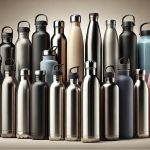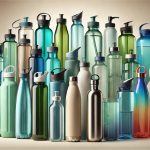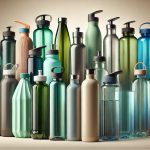Stainless steel water bottles have become increasingly popular due to their durability, sustainability, and ability to keep beverages at desired temperatures for extended periods. Whether you’re using a water bottle for hiking, office work, or day-to-day activities, finding the right one can enhance your experience. In this comprehensive guide, we’ll explore the key factors you should consider when buying a stainless steel water bottle to ensure you select one that suits your lifestyle and needs.
1. Material Quality and Composition
Grade of Stainless Steel
Not all stainless steel is created equal. The quality of the material will affect the durability, resistance to corrosion, and overall performance of the water bottle.
- Food-Grade Stainless Steel: Most high-quality stainless steel water bottles are made from 18/8 or 304 food-grade stainless steel. This type of stainless steel is resistant to rust, corrosion, and leaching, making it safe for holding beverages.
- Medical-Grade Stainless Steel: Some premium water bottles use 316L stainless steel, which offers even greater resistance to corrosion, particularly in harsh environments. This is ideal for those who need extra durability, like people engaging in marine activities.
BPA-Free and Non-Toxic Materials
It’s essential to choose a water bottle that is BPA-free and made from non-toxic materials to ensure that it doesn’t leach harmful chemicals into your drink.
- BPA-Free: Ensure the bottle’s inner coating (if any) or plastic components, such as lids, are BPA-free. BPA (Bisphenol-A) is a chemical found in some plastics and resins, and it has been linked to health risks.
- Non-Toxic Finishes: The exterior of the bottle may be painted or powder-coated. Ensure the finishes are non-toxic and safe for regular handling.
2. Insulation Technology
One of the main advantages of stainless steel water bottles is their ability to maintain beverage temperatures. Insulation technology plays a vital role in this performance.
Double-Walled Vacuum Insulation
- What It Is: Double-walled vacuum insulation involves two layers of stainless steel with a vacuum-sealed space between them. This design prevents heat transfer, keeping beverages hot or cold for extended periods.
- Advantages:
- Keeps Beverages Cold: Some bottles can keep liquids cold for up to 24 hours, which is ideal for athletes, hikers, or anyone on the go.
- Keeps Beverages Hot: If you prefer to carry coffee or tea, insulated bottles can keep beverages hot for up to 12 hours, depending on the model.
- Considerations: Bottles with double-walled vacuum insulation tend to be heavier than single-walled options, but they provide superior temperature retention.
Single-Wall Stainless Steel Bottles
- What It Is: Single-wall bottles are made from a single layer of stainless steel and do not offer insulation. They’re lightweight but not suitable for keeping drinks at a specific temperature for long periods.
- Advantages:
- Lighter Weight: Ideal for short trips or when you don’t need insulation.
- More Compact: Less bulky than double-walled bottles, making them easier to store in small bags.
- Considerations: These bottles are not designed to maintain temperature and may become hot or cold to the touch, depending on the liquid inside.
3. Size and Capacity
Choosing the right size for your stainless steel water bottle depends on how you plan to use it. Different sizes cater to different needs, from daily hydration to long trips.
Standard Sizes
- Small (12-18 oz): Ideal for short outings, commuting, or when you want a more compact bottle to carry in a handbag or backpack. These bottles are often used for quick hydration during short workouts or light activities.
- Medium (20-32 oz): A versatile size for daily use, whether at work, the gym, or on a hike. Medium-sized bottles strike a balance between portability and capacity, making them a popular choice for most people.
- Large (40-64 oz): Best for long trips, outdoor adventures, or individuals who need a high intake of water throughout the day. These larger bottles may be bulkier but are perfect for situations where refilling is not convenient.
Portability
Consider how easy it is to carry the bottle. Larger bottles may be ideal for long trips but could be too bulky for everyday use. On the other hand, smaller bottles are more portable but may require frequent refills.
- Weight: Heavier bottles may be difficult to carry on long hikes or when space is limited. Always balance capacity with portability.
- Size Compatibility: Ensure the bottle fits in your car’s cup holder, backpack pockets, or any other space you plan to carry it in.
4. Lid Types and Functionality
The lid or cap of a stainless steel water bottle plays a significant role in its usability, convenience, and ability to prevent leaks.
Screw-Top Lids
- What It Is: The most common type of lid, featuring a threaded design that screws tightly onto the bottle.
- Advantages:
- Leak-Proof: Screw-top lids typically form a tight seal, minimizing the risk of leaks.
- Simple and Durable: A basic design that is easy to use and clean.
- Temperature Retention: These lids help maintain the bottle’s insulation properties by keeping it airtight.
- Considerations: Screw-top lids may not be as convenient for quick sips during workouts or while driving, as you need to fully unscrew them to drink.
Flip-Top Lids
- What It Is: Flip-top lids feature a small, hinged opening that can be flipped open with one hand, allowing easy access to your drink.
- Advantages:
- Convenient Access: Easy to open and close with one hand, ideal for active lifestyles.
- Great for On-the-Go: Suitable for people who need quick hydration, such as during workouts or outdoor activities.
- Considerations: Flip-top lids may not be as leak-proof as screw-top lids, so they may not be suitable for storing in a bag without proper closure mechanisms.
Straw Lids
- What It Is: A built-in straw that allows you to sip without tipping the bottle.
- Advantages:
- Hands-Free Drinking: Great for situations where you can’t tilt the bottle, such as when driving or exercising.
- Convenience: Ideal for workouts, running, or biking.
- Considerations: Straw lids may require more maintenance and cleaning, as straws can harbor bacteria if not cleaned regularly.
Wide Mouth vs. Narrow Mouth Lids
- Wide Mouth:
- Advantages: Easier to fill with ice cubes, water, or even smoothies. Also makes cleaning simpler, especially when using a bottle brush.
- Considerations: May result in spills if you’re not careful while drinking.
- Narrow Mouth:
- Advantages: Offers controlled drinking and reduces the risk of spilling. Good for on-the-go hydration.
- Considerations: Harder to add ice cubes or clean thoroughly without specialized brushes.
5. Leak-Proof and Spill-Proof Design
Leakage is a major concern when choosing a water bottle, especially if you plan to carry it in a bag or backpack.
Sealing Mechanism
Ensure that the bottle has a secure, tight-sealing mechanism to prevent leaks and spills. The sealing can be in the form of:
- Silicone or Rubber Gaskets: Many bottles use silicone or rubber gaskets to create a watertight seal when the lid is screwed on.
- Locking Mechanism: Some flip-top and straw lids come with an additional locking mechanism to prevent accidental opening.
Testing for Leak Prevention
It’s a good idea to test the bottle’s leak-proof capabilities by filling it with water and shaking it while holding it upside down. This will help determine whether the bottle can be trusted in a bag or when carried horizontally.
6. Durability and Impact Resistance
Durability is one of the key advantages of stainless steel water bottles, but certain factors can affect their longevity.
Stainless Steel Thickness
The thickness of the stainless steel walls can determine the bottle’s ability to withstand dents, dings, and daily wear and tear.
- Thicker Bottles: Thicker bottles are more resistant to damage from drops or impacts, making them a good choice for outdoor adventures or rugged use.
- Lighter Bottles: Lighter bottles, while easier to carry, may dent more easily if dropped.
Scratch and Dent Resistance
Some bottles come with additional coatings or finishes that make them more resistant to scratches and dents.
- Powder-Coated Finish: A powder-coated finish provides extra grip, reduces condensation, and is often more resistant to scratches.
- Brushed Stainless Steel: Brushed stainless steel has a sleek, modern appearance and is often more scratch-resistant than polished stainless steel.
7. Cleaning and Maintenance
Maintaining the cleanliness of your stainless steel water bottle is crucial for health and longevity.
Dishwasher Safe vs. Hand-Washing
Some stainless steel water bottles are dishwasher-safe, while others may require hand-washing.
- Dishwasher-Safe Bottles: Look for bottles specifically labeled as dishwasher-safe if you prefer easy cleaning. However, some manufacturers recommend hand-washing to preserve the bottle’s finish and insulation.
- Hand-Washing: Bottles with more delicate finishes or complex lids (like those with straws or flip-tops) may need to be hand-washed. A bottle brush can help you reach deep inside.
Easy to Clean Design
Bottles with fewer parts and wide mouths are generally easier to clean. Ensure the bottle has minimal nooks and crannies where bacteria could grow.
- Wide Mouth Design: Easier to clean and allows for more thorough scrubbing.
- Removable Parts: Lids, straws, and gaskets should be easy to remove and clean separately.
8. Environmental and Health Considerations
Stainless steel water bottles are more eco-friendly than single-use plastic bottles, but it’s important to consider their full environmental impact.
Reusability and Sustainability
Choosing a high-quality stainless steel water bottle reduces the need for disposable plastic bottles, helping minimize your environmental footprint.
- Reusable Design: Stainless steel bottles can last for years, making them a more sustainable choice than plastic or even glass bottles.
- Sustainable Materials: Opt for bottles that are made with environmentally responsible manufacturing processes or recycled materials.
Safe Materials
Ensure the bottle is made from safe materials, especially if you plan to store hot liquids or acidic beverages.
- Food-Grade Materials: Look for bottles made with food-grade stainless steel, which ensures that the material is safe for long-term use with both hot and cold beverages.
- Non-Reactive Materials: High-quality stainless steel is non-reactive, meaning it won’t leach chemicals or flavors into your drink.
9. Special Features
Some stainless steel water bottles come with additional features that can enhance convenience or provide added value.
Built-In Filters
Some bottles feature built-in filters that allow you to fill them with tap water or from natural sources like streams, making them ideal for outdoor activities or travel.
- Removable Filters: These are often designed to filter out bacteria, chlorine, or other impurities from drinking water.
- Considerations: Make sure filters are easy to replace and that the bottle can be used without the filter if necessary.
Time Markers or Hydration Reminders
To help you stay on track with your hydration goals, some bottles come with time markers or reminders printed on the side.
- Time-Stamped Markers: Show how much water you should be drinking at certain times of the day.
- Hydration Apps: Some high-tech bottles connect to mobile apps that track your water intake and send reminders when it’s time to hydrate.
Carrying Handles or Straps
A built-in handle, loop, or strap can make it easier to carry your water bottle on the go, especially when hiking, camping, or running errands.
- Carrying Loops: Integrated into the lid for easy carrying or attaching to backpacks.
- Detachable Straps: Adjustable or detachable straps make the bottle more portable and versatile.
Customization Options
Some brands offer customization options for stainless steel water bottles, allowing you to personalize your bottle with engravings, colors, or custom designs.
- Laser Engraving: Permanent markings or designs etched onto the bottle, which can include names, logos, or other personalized elements.
- Custom Colors and Patterns: Some companies allow you to choose from a variety of colors or patterns to make the bottle uniquely yours.
10. Price and Brand Considerations
When buying a stainless steel water bottle, price can vary significantly based on the brand, size, insulation, and additional features.
Budget-Friendly Options
There are plenty of affordable stainless steel bottles available, offering durability and functionality without breaking the bank.
- Price Range: Typically between $15 to $30.
- Best For: Those who want a basic, durable bottle without additional features like advanced insulation or high-tech lids.
Mid-Range Options
Mid-range bottles offer a balance between quality, features, and price. These bottles often come with insulation, convenient lids, and durable finishes.
- Price Range: Between $30 to $50.
- Best For: Individuals who want a long-lasting bottle with insulation for keeping beverages hot or cold.
Premium Options
High-end stainless steel water bottles often feature premium materials, advanced insulation, and specialized features like built-in filters or smart technology.
- Price Range: $50 and above.
- Best For: Buyers looking for top-tier quality, advanced technology, or a luxury water bottle that combines style and function.
11. Warranty and Customer Support
A warranty can provide peace of mind when purchasing a stainless steel water bottle, especially if you’re investing in a high-end model.
Warranty Coverage
Many reputable brands offer warranties that cover defects in materials or workmanship.
- Limited Warranty: Most manufacturers offer a one- or two-year warranty, covering defects but not damage from regular wear and tear.
- Lifetime Warranty: Some brands offer lifetime warranties, which are a testament to the durability and quality of their products.
Customer Support
Reputable brands typically provide better customer support, making it easier to resolve issues, replace defective parts, or return products if necessary.
- Responsive Support: Choose a brand known for responsive and helpful customer service.
- Return Policies: Check if the brand offers hassle-free returns or replacements if the product doesn’t meet your expectations.
Conclusion
When buying a stainless steel water bottle, it’s essential to consider a range of factors, from material quality and insulation technology to size, lid types, and special features. A high-quality stainless steel water bottle not only offers convenience and portability but also helps you stay hydrated while reducing your environmental impact. Whether you need a lightweight bottle for daily use, an insulated bottle for outdoor adventures, or a high-tech option with added functionality, this guide provides all the information you need to make an informed decision that aligns with your lifestyle and preferences.







